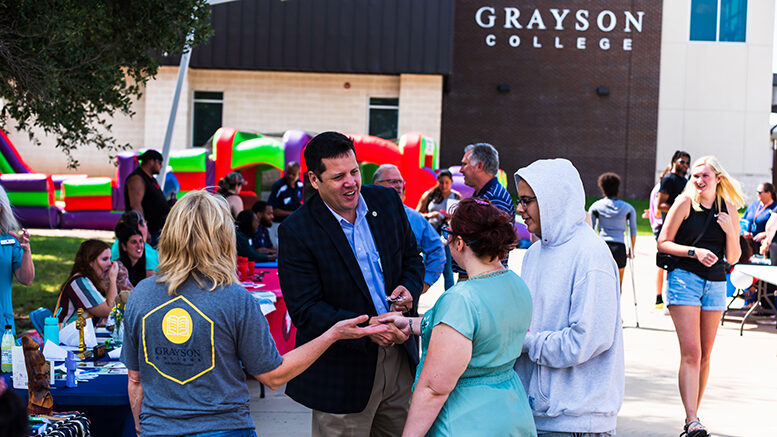Grayson College – like all colleges – is always searching for ways to advance student success.

In looking at where students typically stall or stop out, a trend emerged: at around the ninth week of a 16-week semester, a student’s car would break down, a work schedule would shift or students would have some other emergency that prevented them from getting to class — and soon they’d stop coming altogether.
That meant not only were students losing out on credits, but many also had to return their financial aid.
“If students have to return financial aid, they just don’t come back to college,” says Grayson College President Jeremy McMillen.
McMillen, Kilgore College President Brenda Kays and Christine Bailie of the Texas Association of Community Colleges will discuss scaling eight-week terms for institutional transformation at a session during the 2023 AACC Annual April 1-4 in Denver. Register today.
So, the Texas college decided to try something different and moved to eight-week terms for its academic transfer classes. During these shorter sessions, students take just two classes.
Grayson had already offered a few eight-week classes, primarily online. But now it was looking at a big operational change, which was no easy task.
“It’s not just about modifying the calendar,” McMillen says. It’s a “cultural commitment.”
It also had to be done with intention. It had to align with the college’s guided pathways work and strategic planning goals to “Connect, Commit and Complete.”
Getting there
Fortunately, a few colleges in Texas had already made this conversion and were seeing success with eight-week terms. Odessa and Amarillo colleges, in particular, were seen as models.
Odessa College switched to shorter terms in 2014. According to a report from Achieving the Dream, two years after launching its 8-week terms, Odessa saw a 13% overall increase in enrollment. That grew to 25% after five years.
With some guidance from faculty and staff at Odessa and Amarillo, Grayson didn’t have to reinvent the wheel.
A critical component in the move was early faculty engagement – and ensuring faculty had the time and supports needed to reimagine their classes. There were some faculty concerns, McMillen says, but for the most part, faculty members were all in.
“There was a deep level of commitment required by everyone on our team and a heroic effort to get to eight-week terms,” he says.
“Courage and confidence” were required during the process – including when figuring out the financial aid piece.
The financial aid part
Since federal financial aid and state rules are built around 16-week schedules, the college had to consider how to package financial aid. The bureaucracy can make innovation tricky, McMillen says.
When eight-week terms launched in fall 2018, students had to buy into it, too, and learn how both the scheduling and financial aid pieces work. Students’ aid is packaged based on a full 16-week semester (or two eight-week terms). If they can’t attend the second eight-week term, the college repackages their financial aid.
Though the transition to eight-week terms was challenging, the results have been positive: the time-to-degree has accelerated as the model has pushed more students to enroll full-time.
Slow and steady
At Kilgore College, President Brenda Kays also was inspired by what was happening at Odessa and Amarillo colleges.
“When you start seeing some of the data points associated with the model, it’s hard not to take it seriously. Those are the kind of success rates we all want with our students,” Kays says.
The data also helped with faculty buy-in when student success initiatives were being discussed. The move to eight-week terms was faculty-driven.
“That’s what made it successful,” Kays says.
Kilgore staff and faculty spent a year honing policies and procedures and building classes gradually.
“There’s a special art to converting a 16-week course into an eight-week course,” Kays says.
There was a lot to consider: For example, would it work with night classes? Would students want that? It turns out, students did want that. And classes with labs, such as anatomy and physiology, took longer to convert.
What the data show
The eight-week term model, called “Focus to Finish,” launched in fall 2019. And, like with Grayson College, results have been good.
In fact, “some of the data took my breath away,” Kays says.
Prior to launch of eight-week terms, the 150% graduation rate at Kilgore was 26%. For the 2019 cohort, the 150% graduation rate rose to 33%. The numbers are even more astonishing when disaggregated. For the Black student population, the graduation rate was 9% for the 2016 cohort. It rose to 25% for the 2019 cohort.
Kays says the eight-week model works particularly well for the “middle 50%” of high school graduates. The top 25% of grads already have skills and “will be successful no matter what,” she says, but “the middle 50% of students need this kind of model to help them.”
The model also provides more on-ramps for students. During the second eight-week term of each semester, about 65 to 80 new students enroll to try out Kilgore, according to Kays.
Help during the pandemic
During the height of the Covid pandemic, shorter terms also benefitted students and the colleges. At Grayson College, the “grand awareness we were in a pandemic” occurred at the end of the first eight weeks of the spring semester. That meant students could finish two classes before everything changed.
“We hit pause for a week and delayed the start of the second eight weeks,” McMillen says. Students who had to stop out could do so without losing an entire semester.
“This gave us flexibility that other institutions may not have,” he says.
That flexibility helped.
“Interestingly, we had the highest course completion rate and retention rate of existing students we’ve ever had,” McMillen says.
Kilgore saw some “slippage” in its completion and retention rates during the pandemic, but numbers are bouncing back and “students are continuing to do well with this model,” Kays says.
Grayson and Kilgore colleges are now mentoring other community colleges in Texas and sharing their models of success.
Eight-week terms may not be the standard yet, but “there are different ways of doing things. We are recognizing those things that work for students,” Kays says.

